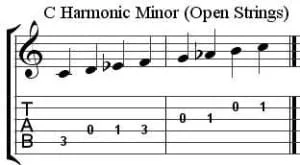
Harmonic Minor Scale
Oct 22, 2020A Jazz Guitar Lesson
What is the Harmonic Minor Scale:
The harmonic minor scale is built of seven notes that are laid out using intervals. W H W W H -3 H (W= whole-step, H=half-step, -3=minor third) and is commonly used by jazz musicians. It has a darker "Arabic" sound because of the lowered third and sixth degrees (when compared to major). It has been used, much like the major scale, in traditional and classical music for centuries.
In Jazz music, the harmonic minor scale can be heard a lot on minor II-V-I cadences, or used when some kind of altered dominant chords are used. For instance, the chord G7(b13, b9) comes straight from C harmonic minor scale!
On the guitar, this scale can be played in the open position like this:

Or it can be played using only one string at a time, aka an "horizontal approach". The single-string option really "shows" the scale to you. Every interval (distance between two notes) is clearly defined. Notice the leap created by the largest interval between two consecutive notes:
Also, I strongly believe you should learn to really hear the sound of this scale, specifically the leap (between the Ab and the B notes above). Understanding the theory is optional in the beginning. I suggest you play and learn this scale from an aural perspective at first.
Also, it is highly common for jazz guitarists to sing along to their playing. Try it! It helps to reinforce the link between your fingers (what you play) and you ears (what you hear inside.)
Scale Construction
The harmonic minor scale is built of seven notes that are laid out using intervals. The half-step interval is one fret away, the whole step is two frets away and the minor third is three frets. The minor third can also be qualified as "three half-steps" or "a whole step and a half".
The formula for the construction is:
W H W W H -3 H
(W= whole-step, H=half-step, -3=minor third)
The numeric formula is: 1 2 b3 4 5 b6 7
(it means that in comparison to the major scale, the harmonic minor scale has a b3 and b6)
The lowered third degree gives the "sadness" in the sound. The b6 on the other hand gives "brightness" because it creates a leap to the seventh degree. It easy to "see" when played on a single string. Remember, the formula for the major scale is 1 2 3 4 5 6 7 while the formula for the melodic minor scale is 1 2 b3 4 5 6 7.
In Position
Finally, the harmonic minor scale can also be played "in position" (one finger to a fret). This is usually what is taught in guitar methods. It is a very good way to "compartmentalize" the neck. You will get familiar with the whole instrument dealing with it chunk by chunk.

My two cents: unlike the major scale (which is really easy to play in positions, see this article series), the harmonic minor scale will give you some problem. It is the leap between the degrees b6 and 7 that create headaches. So, whenever something does not quite "fit" in position, feel free to go out of the scale position and find comfortable fingerings that work for you.
**Note from the editor** This post was updated 10/23/2020. (Feature image updated and layout changes.)









